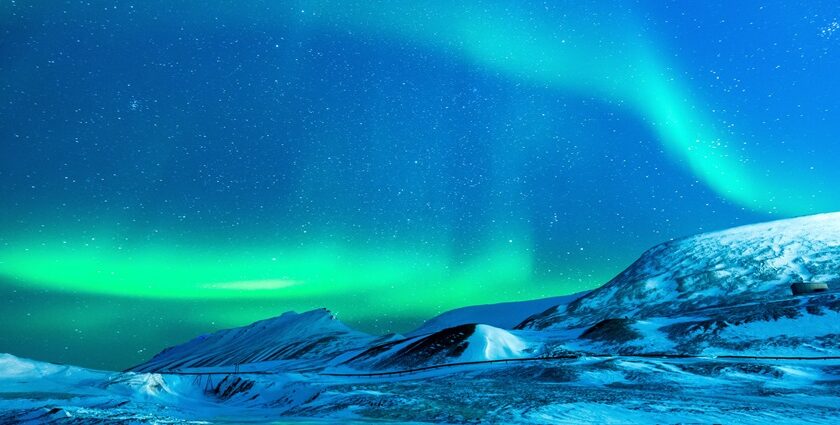The Northern Lights, or Aurora Borealis, are one of nature’s most mesmerising spectacles, with shimmering curtains of green, purple, and red dancing across the Arctic sky. If you’re someone drawn to rare natural wonders, planning your visit around the best places to see the Northern Lights can turn your trip into a memorable experience. With the Sun’s current solar maximum peaking between 2024 and early 2026, this is a rare window to see the lights at their brightest. It’s a once-in-a-lifetime experience for photographers and those seeking quiet escapes.
What Are The Northern Lights
The Northern Lights occur when charged solar particles collide with gases in Earth’s upper atmosphere, releasing energy as glowing arcs, ripples, or curtains of light. Unlike a static glow, auroras constantly shift in colour and movement, creating new patterns minute by minute. Their intensity follows the Sun’s 11-year cycle, making some years more spectacular than others.
The major places to see the Northern Lights are close to the Earth’s magnetic poles, especially within the Arctic Circle. Clear skies, low light pollution, and high solar activity together produce the most vivid and awe-inspiring displays.
9 Best Places To See The Northern Lights
The magic of the Northern Lights comes alive only in certain regions. Let’s discover the best places to see the Northern Lights around the world.
1. Iceland
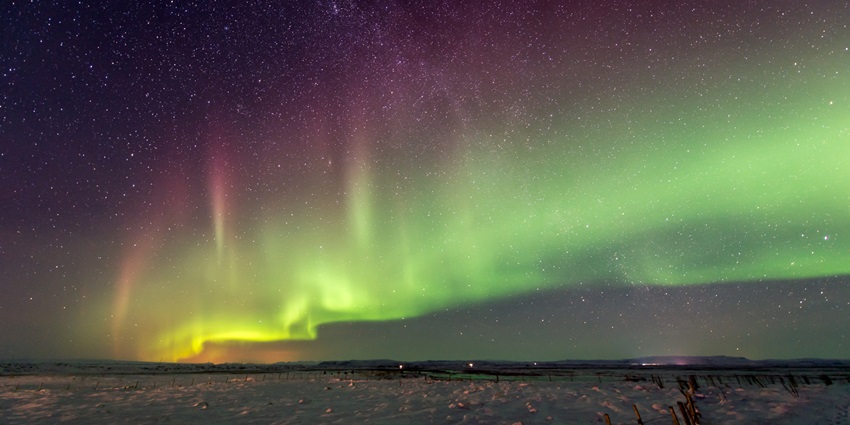
Photo: Cameron Pickett / Wikimedia Commons / Image For Representation Only
Iceland is one of the best places to see the Northern Lights in the world, offering a rare combination of dark skies and expansive landscapes. The aurora can occasionally be seen from Reykjavik, but the best displays often require travel to darker, less populated areas. Jökulsárlón Glacier Lagoon is one of the best places in Iceland for Northern Lights and requires longer drives from the city centre, so plan overnight stays nearby. The weather is quite unpredictable, as sudden snow, rain, or low clouds often block the view, so check the forecast.
Key Locations: Reykjavik, Þingvellir National Park, Jökulsárlón Glacier Lagoon, Westfjords and Akureyri
Best Time To Visit: September to April; peak activity during February–March
How To Reach: Direct flights from Delhi, Mumbai, and Bangalore connect via hubs like London, Paris, or Frankfurt to Keflavik International Airport near Reykjavik
Notable Local Experiences: Golden Circle tour, glacier hikes, ice caves, hot springs, and photography tours
Suggested Read: Places To Visit In Iceland For Adventure Seekers
2. Finland
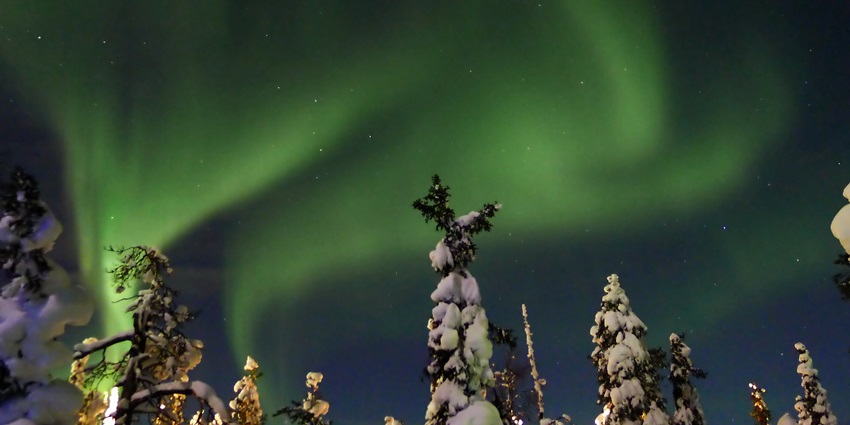
Photo: Timo Newton-Syms / Wikimedia Commons
Lapland in northern Finland offers some of Europe’s most reliable aurora sightings; however, keep a check on clear skies, as snow and clouds can quickly block the view. Rovaniemi is the best place to go to see the Northern Lights due to its access to dark-sky areas, while Saariselkä and Levi provide quieter areas for uninterrupted viewing. For the best experience, book a glass igloo or an aurora-ready cabin where you can enjoy the spectacle above snow-covered landscapes or frozen lakes comfortably.
Key Locations: Lapland, Rovaniemi, Inari, Levi & Saariselkä
Best Time To Visit: Late September to early April; December–March offers long nights
How To Reach: Fly from Delhi, Mumbai, or Bengaluru to Helsinki (via Frankfurt, London, or Amsterdam), then take a domestic flight to Rovaniemi/Inari
Notable Local Experiences: Dog sledging, reindeer safaris, glass igloos, snowmobile trips, and Sami cultural experiences
3. Norway
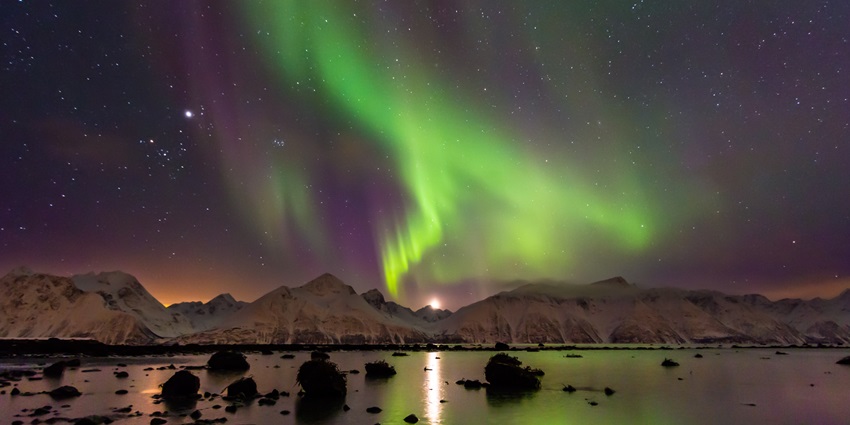
Photo: Carsten / Wikimedia Commons
Northern Norway is renowned for its dramatic Arctic landscapes and frequent Northern Lights. Tromsø, being a convenient base, is the best place for Northern Lights in Norway, close to fjords and mountains where the aurora appears vividly. You can stay in hotels or lodges in Tromsø for comfort, or choose smaller cabins and guesthouses closer to remote vantage points for a more immersive experience. Svalbard and the Lofoten Islands offer quieter skies for those willing to travel further.
Key Locations: Tromsø, Svalbard, Lofoten Islands
Best Time To Visit: October to March; December–February for peak darkness
How To Reach: Fly from Delhi, Mumbai, or Bengaluru to Oslo via London, Frankfurt, or Amsterdam; then take a domestic flight to Tromsø or Svalbard
Notable Local Experiences: Fjord cruises, whale watching, snowshoeing, Sami cultural tours, photography trips
Suggested Read: Places To Visit In Norway
4. Sweden
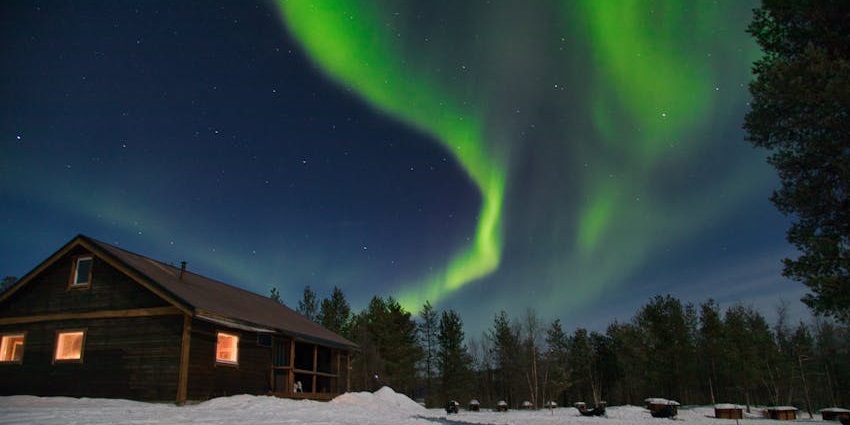
Sweden’s Abisko National Park is one of the favourite places to see the Northern Lights among photographers, thanks to its proximity to the ‘Blue Hole’, a microclimate that often keeps skies clear. Kiruna, about an hour away, provides convenient access to the surrounding mountains and wilderness. You can stay in hotels or lodges in Kiruna, or choose remote cabins near Abisko to maximise your viewing opportunities. You’re more likely to see long-lasting, powerful displays in shades of green, purple, and red if you plan a long stay here.
Key Locations: Abisko National Park, Jukkasjärvi (Icehotel), and Kiruna
Best Time To Visit: September to March; clear skies are best in Abisko
How To Reach: Fly from Delhi, Mumbai, or Bengaluru to Stockholm via London, Frankfurt, or Amsterdam; then take a domestic flight/train to Kiruna/Abisko
Notable Local Experiences: Icehotel stay, dog sledging, snowmobile safaris, aurora photography workshops
5. Canada
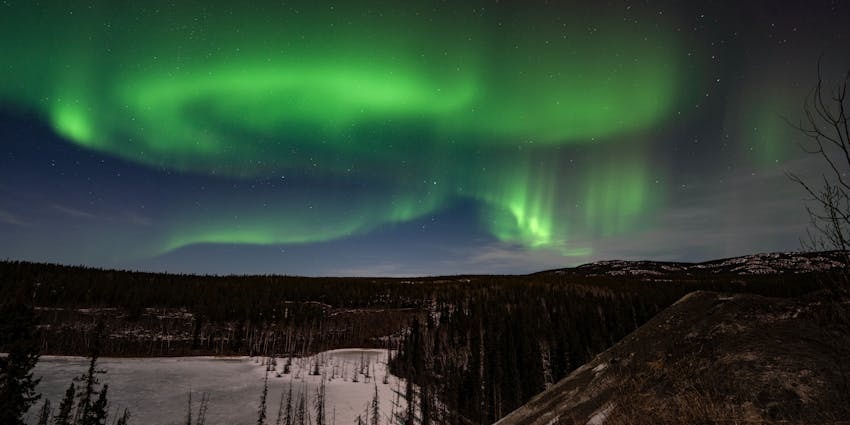
Chasing the Northern Lights in Canada is best in the Yukon, Northwest Territories, and northern Alberta, where clear, dark skies maximise visibility. Yellowknife in the Northwest Territories is famously bright due to minimal light pollution and its location under the auroral oval. For a 360° spectacle, you may head to Whitehorse in Yukon or Jasper National Park in Alberta. Peak season has cold and crisp nights. However, compared to harsher Arctic regions, Canada is considered among the warmest places to see the Northern Lights, making the experience more comfortable.
Key Locations: Yukon, Yellowknife, Alberta, and Nunavut (Iqaluit)
Best Time To Visit: Late August to April; February–March is prime
How To Reach: Fly from Delhi/Mumbai/Bengaluru to Toronto/Vancouver/Calgary via London, Frankfurt, or Amsterdam; then take a domestic flight to Yellowknife or Whitehorse
Notable Local Experiences: Ice fishing, dog sledging, aurora photography tours, and wildlife spotting
Suggested Read: Discover Hidden Places In Canada That Offer Breathtaking Views And Unforgettable Escapes
6. Greenland
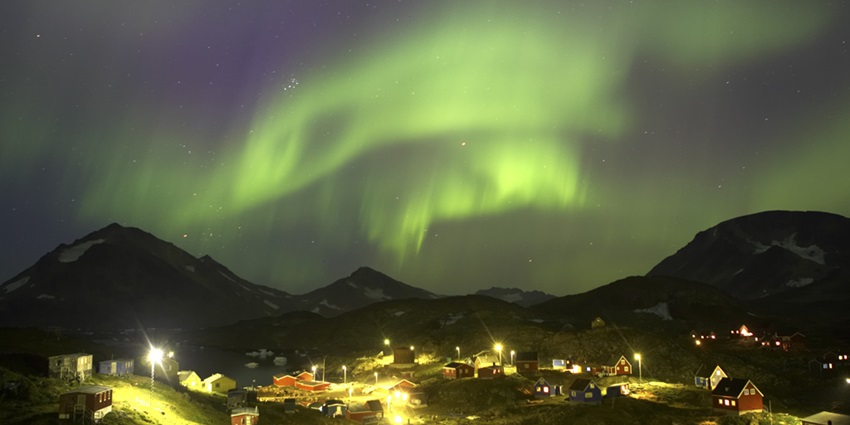
Photo: Nick Russill / Wikimedia Commons
If you’re planning to visit Greenland, head to remote places for Northern Lights, like Kangerlussuaq, Ilulissat, or Sisimiut, as they offer long nights and minimal light pollution. The lights shimmer over icy fjords and glaciers, drawing photographers from all over the world eager to capture their brilliance. Plan for longer stays to increase your chances of sightings and join local aurora tours to reach the best viewing spots.
Key Locations: Kangerlussuaq and Kulusuk
Best Time To Visit: September to April; peak activity during December–March
How To Reach: Fly from Delhi, Mumbai, or Bengaluru to Copenhagen (via London, Frankfurt, or Amsterdam), then Air Greenland to Kangerlussuaq or Ilulissat
Notable Local Experiences: Icefjord cruises, dog sledging, Inuit cultural experiences, glacier hiking
7. Alaska
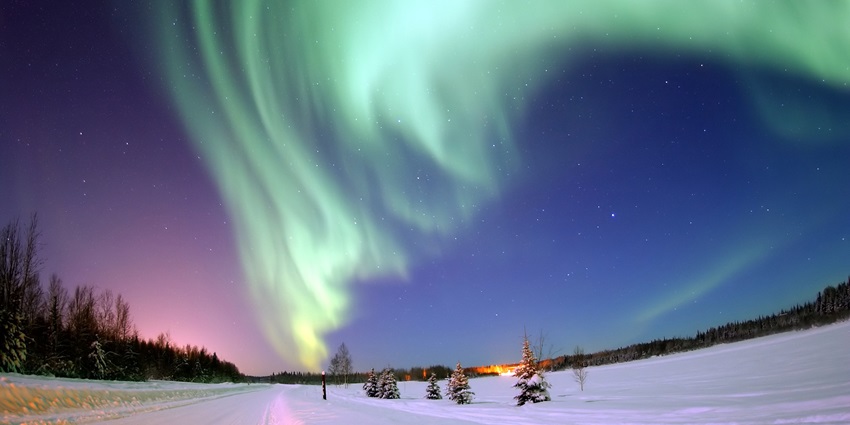
Photo: United States Air Force / Wikipedia
Fairbanks, Alaska, is one of the best places in the world to see the Northern Lights and offers access to nearby dark-sky areas and aurora lodges. Some of the best viewing spots require short drives from Fairbanks, such as Chena Lakes, Murphy Dome, or Creamer’s Field. The aurora can cover large portions of the sky and last for hours, making extended observation rewarding. Winter temperatures can drop sharply, and snowstorms occasionally limit visibility, so check the weather forecast before visiting.
Key Locations: Fairbanks
Best Time To Visit: Late August to April; December–March offers long nights
How To Reach: Fly from Delhi, Mumbai, or Bengaluru to Anchorage or Fairbanks via Seattle, San Francisco, or Chicago
Notable Local Experiences: Chena Hot Springs, wilderness aurora tours, dog sledging, scenic hikes
Suggested Read: Explore The 11 Best Places To Visit In Alaska For A Scenic Adventure
8. Scotland
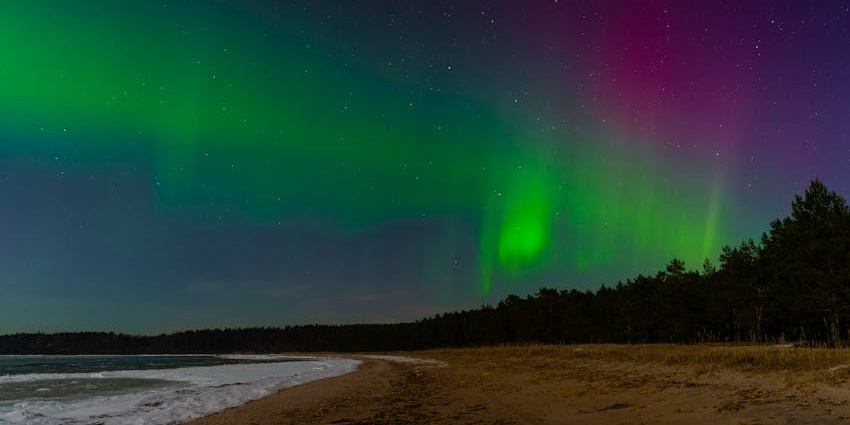
Photo: Raul Kozenevski / Pexels / Image For Representation Only
Scotland isn’t a destination solely for aurora viewing, yet you can combine it with trips exploring the Highlands. You can see the Northern Lights, or “Mirrie Dancers,” from the northern regions like Aberdeenshire, Caithness, and the Highlands. The displays are less frequent and weaker than in Arctic destinations, but still offer a rare and memorable sight. For the clearest views, head to the open countryside around Caithness or coastal spots like Durness and the Moray Coast.
Key Locations: Aberdeen, Shetland Islands and Cairngorms National Park
Best Time To Visit: November to February
How To Reach: Fly from Delhi, Mumbai, or Bengaluru to Edinburgh or Glasgow via London or Amsterdam; drive or take a domestic flight to the Cairngorms/Shetlands
Notable Local Experiences: Winter hikes, castles, dark-sky photography, and local whisky tasting
9. Russia
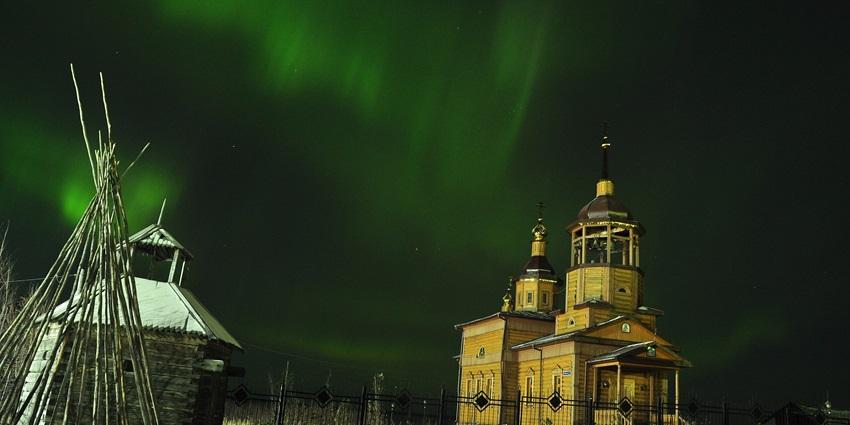
Photo: Nikolay Fedotov / Wikimedia Commons
In Russia, Siberia offers some of the best places to see the Northern Lights. The aurora often fills the wide Arctic skies with green, purple, and occasional red hues, creating long-lasting displays. Cities are far apart, so you may head to rural areas or small settlements like Norilsk or Yakutsk for increased visibility and reduced light pollution. Snow-covered forests, frozen rivers, and icy plains enhance reflections, making the display even more vivid.
Key Locations: Murmansk, Kola Peninsula and Siberia
Best Time To Visit: September to March; peak aurora activity during winter months
How To Reach: Fly from Delhi, Mumbai, or Bengaluru to Moscow or St. Petersburg via Doha, Dubai, or Frankfurt; then take a domestic flight to Murmansk/Kola Peninsula
Notable Local Experiences: Snowmobiling, ice fishing, indigenous cultural experiences, and photography expeditions
Suggested Read: Best Places To Visit In Russia
Essential Tips For Planning Your Northern Lights Trip
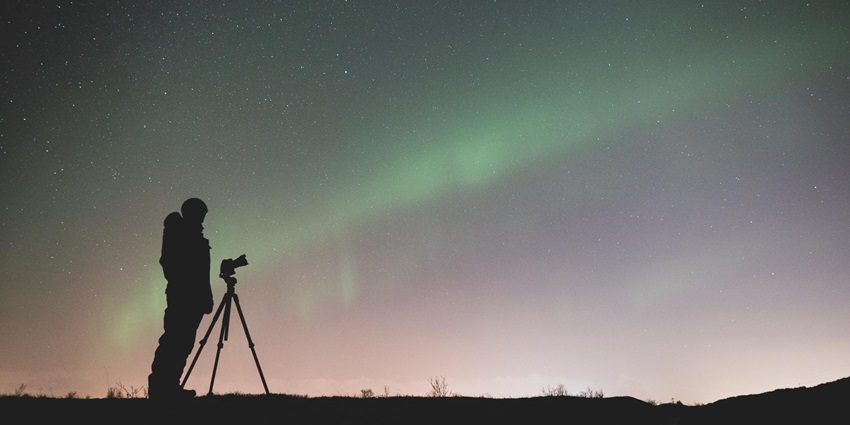
Now that you know the best places for Northern Lights, explore practical tips to make your aurora experience memorable and truly rewarding.
1. Check Aurora & Weather Forecasts: Before heading out, check both the aurora and local weather forecasts. Clear skies, low cloud cover, and peak solar activity are essential. Official sources like NASA Aurora Forecast or country-specific meteorological sites provide reliable updates.
2. Plan Travel & Accommodation: Consider your base carefully. City hotels are convenient and budget-friendly, while remote lodges, glass igloos, or aurora-ready cabins offer the best viewing opportunities. Plan at least 3–5 nights in one location for higher chances of sightings.
3. Carry Layered Clothing & Gear: Arctic nights are extremely cold, often below −20°C in winter. So, carry layered clothing, insulated jackets, thermal boots, gloves, hats, and scarves. Bring a headlamp with red light and portable hand warmers to stay comfortable during long outdoor stints.
4. Choose Guided Tours Or Solo Trips: Beginners or short-stay travellers may benefit from guided tours to remote places for Northern Lights, which also provide insights about the aurora. If you are confident in navigating remote areas, solo trips offer more flexibility.
5. Aurora Photography Tips: Use a DSLR or mirrorless camera with a wide-angle lens and manual settings, mounted on a sturdy tripod. Experiment with long exposures and foregrounds like lakes or mountains for dramatic shots. Don’t forget extra batteries, as cold nights drain power quickly.
From the icy landscapes of Iceland to the Arctic wilderness of Norway, the places to see the Northern Lights promise nights filled with colourful skies. Each location offers a unique combination of dramatic scenery, winter adventures, and cultural immersion for a truly magnificent experience. With such helpful insights and tips from TripXL, plan your Northern Lights adventure and capture timeless moments beneath the dancing lights. Follow for more!
Cover Photo: Noel_Bauza / Pixabay / Image For Representation Only


 WhatsApp
WhatsApp
 Twitter
Twitter
